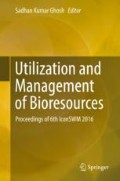Abstract
The utilization of biogenetic waste and residues draws more and more attention worldwide, driven by the fight against climate change and the efforts to save greenhouse gas emissions. Biodegradable waste and residuals already contribute to energy supply and are used in new biorefinery concepts. The potential of remaining available wastes and residues is compared to the small energy crop potential but important for climate protection goals. In total 98.4 million tons dry mass represent the technical potential that means it is available for utilization in Germany. 30.9 million tons of this technical potential is currently not in use. The biogas sector in Germany is highly developed but has to be further developed as well as the other bioenergy sectors to fulfil the future tasks. The German energy transition has yet not reached its ambitious goals; the process stagnated in certain areas. Biomass and waste biomass must contribute to development a bioeconomy by the combined material and energy utilization in biorefineries and contribute to the energy transition in combination with the other renewable energies. Examples for enhanced energetically utilization of biowaste as well as biorefinery concepts are described.
Access this chapter
Tax calculation will be finalised at checkout
Purchases are for personal use only
References
AVA (2016) Abfallverwertung Augsburg, Energie, Biogas, http://www.ava-augsburg.de/energie/biogas. Last access 20 June 2016
Bauer WP, Kroner T, Meier G (2014) Kombination von Vergärung mit Abfallverbrennung – energetische und wirtschaftliche Synergien. In: Strategie Planung Umweltrecht 8 (2014), TK Verlag – Fachverlag für Kreislaufwirtschaft (January 2014), pp 101–109
Bloche-Daub K, Witt J, Lenz V, Nelles M (2015) Märkte und Trends von regenerativen Energien weltweit, in der EU und in Deutschland. In: Herbes C, Friege C (Hrsg) Marketing Erneuerbarer Energien – Grundlagen, Geschäftsmodelle, Fallbeispiele, S 29–59, ISBN 978-3-658-04967-6. doi:10.1007/978-3-658-04968-3_2
BMBF (2014) Bioökonomie in Deutschland Chancen für eine biobasierte und nachhaltige Zukunft, Hrsg.: Bundesministerium für Bildung und Forschung (BMBF) and Bundesministerium für Ernährung und Landwirtschaft (BMEL), Berlin 2014
BMWi (2016) Zeitreihen zur Entwicklung der erneuerbaren Energien in Deutschland, Bundesministerium für Wirtschaft und Energie (BMWi, Hrsg.) unter Verwendung von Daten der Arbeitsgruppe Erneuerbare Energien-Statistik (AGEE-Stat), Stand: Februar 2016
Brosowski A, Mantau U, Mahro B, Thrän D, Adler P, Erdmann G, Stinner W, Blanke C, Hering T, Reinholdt G (2015) Biomassepotenziale von Rest- und Abfallstoffen – Status quo in Deutschland, Schriftenreihe Nachwachsende Rohstoffe, Bd. 36, Fachagentur Nachwachsende Rohstoffe e.V., 2015, ISBN 978-3-942147-29-3
FNR (2016) Einheimische Bioenergie kann 2050 bis zu 26 Prozent unseres Primärenergiebedarfs decken, press release 27.04.16. http://www.fnr.de. Last access at 17 June 2016
Hoffstede U (2013) FlexHKW – Flexibilisierung des Betriebes von Heizkraftwerken. In: Konferenzreader 5. Statuskonferenz “Energetische Biomassenutzung”, 14./15. November 2013 in Leipzig, DBFZ, Leipzig, pp 496–499
Holzhammer U, Nelles M, Scholwin F (2013) Auswirkungen der flexiblen Stromproduktion aus Biogas auf den konventionellen Kraftwerkspark und dessen CO2-Emissionen, In: Kern M, Raussen T (Hrsg) Optimierte Erfassung und Verwertung von Bioabfall, Reihe Witzenhausen-Institut, Neues aus Forschung und Praxis, S. 145–167, Dezember 2013, ISBN 3-928673-65-3
Holzhammer U, Stelzer M, Nelles M, Scholwin F (2015) Die neue Flexibilität der Stromwirtschaft und die zukünftige Rolle der Abfallwirtschaft, In: Erich-Schmidt-Verlag (Hrsg) Müll und Abfall, 02.15, S. 79–89. ISBN 978-3-503-12493-0
Krengel U (2015) Flexible Stromproduktion mit Heizkraftwerken möglich, IWES press Release 29. Oktober 2015, pp 1–2
Lange A (2016) Quo vadis BAVA Schwerinum? Bioabfallverwertungsanlage Schwerin – erst Betriebserfahrungen. In: Conference proceedings of the 17. DIALOG Abfallwirtschaft MV 15. June 2016, ISBN 978-3-86009-432-7, pp 113–124
Lenz V (2016) SmartBiomassHeat – Wärme aus Biomasse im Verbund der erneuerbaren Energien. In: Conference proceedings of the 10. Rostocker Bioenergieforum, 16.-17.06.2016 in Rostock, ISBN 978-3-86009-433-4, pp 83–96
Mauky E, Jacobi HF, Liebetrau J, Nelles M (2014) Flexible biogas production for demand-driven energy supply – feeding strategies and types of substrates. Bioresour Technol 178:262–269. doi:10.1016/j.biortech.2014.08.123
Morscheck G, Schüch A, Lemke A, Nelles M (2015) Biowaste recycling in Germany – further challenges. In: Conference proceedings of the 5th international conference on Solid Waste Management (5 IconSWM2015) from 25–27 November 2015, at the Indian Institute of Science, Bangalore, India
Nelles M, Grünes J, Rensberg N, Schüch A (2015) Utilization of organic waste and residues in Germany. Appl Mech Mater 768:714–721. doi:10.4028/www.scientific.net/AMM.768.714. ISSN 1662-7482
Schüch A, Daniel-Gromke J, Liebetrau J, Nelles M (2014) Stand und Perspektiven der Abfall- und Reststoffvergärung in Deutschland. In: Fachverband Biogas (Hrsg) BIOGASJournal 2/2014, S. 34–38, ISSN 1619-8913
Thrän D, Seitz ST, Wirkner R, Nelles M (2016) Die Rolle der Bioenergie in der Energiewende – das „Smart Bioenergy“-Konzept. In: Conference proceedings of the 10. Rostocker Bioenergieforum, 16.-17.06.2016 in Rostock, ISBN 978-3-86009-433-4, pp 15–27
UBA (2016) Netto-Bilanz der vermiedenen Treibhausgas-Emissionen durch die Nutzung erneuerbarer Energien (2015), Umweltbundesamt (UBA), Emissionsbilanz erneuerbarer Energieträger, unter Verwendung von Daten der AGEE-Stat, Stand: März 2016
Verbio (2016) Bioraffinerie. http://www.verbio.de/nachhaltigkeit/bioraffinerie/. Last access at 17 June 2016
Author information
Authors and Affiliations
Corresponding author
Editor information
Editors and Affiliations
Rights and permissions
Copyright information
© 2018 Springer Nature Singapore Pte Ltd.
About this paper
Cite this paper
Nelles, M., Brosowski, A., Morscheck, G., Schüch, A. (2018). Biogenic Waste and Residues in Germany: Amount, Current Utilization and Perspectives. In: Ghosh, S. (eds) Utilization and Management of Bioresources. Springer, Singapore. https://doi.org/10.1007/978-981-10-5349-8_1
Download citation
DOI: https://doi.org/10.1007/978-981-10-5349-8_1
Published:
Publisher Name: Springer, Singapore
Print ISBN: 978-981-10-5348-1
Online ISBN: 978-981-10-5349-8
eBook Packages: Earth and Environmental ScienceEarth and Environmental Science (R0)

